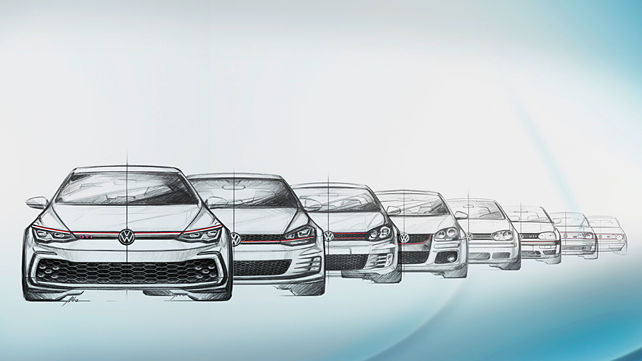
Volkswagen has got off to a successful start in 2021 despite the global shortage of semiconductors and restrictions due to the coronavirus pandemic. Sales revenue in the first quarter grew by 5.4% to €20 billion.
The Volkswagen Passenger Cars brand is present in more than 150 markets worldwide, and the company delivered around 5.3 million vehicles in 2020. These include bestsellers such as the Golf, Tiguan, Jetta or Passat as well as the fully electric successful models ID.3 and ID.4.
Some interesting sub-brands has also been supporting VW to script its success stories. One among them is Golf, which has been in the market for about half a century. The Golf GTI, which is now in its eighth generation, was a cult car.
Golf GTI Mk 1
The original GTI hit the European market in 1976, and it could be identified by the narrow bumper, which was replaced by broader, plastic-covered bumpers in 1978. The first GTI emblem is chrome and intentionally presents a stark contrast with the black Volkswagen logo. Marco Pavone, Head of Exterior Design for the new Golf GTI, says, “Even with the original GTI, all the design elements already reflect a clear attitude.”
Golf GTI Mk 2
Pavone views that the design of the second-generation Golf GTI as a fascinating development. Initially, sporting twin headlights, like its predecessor, the 16-valve version of the second-generation car came with integrated foglights from 1988—each located next to the headlights. For the first time, it came with an additional air intake. Overall, the design continues the conceptual course of the first generation but being larger, wider, and more comfortable.
Golf GTI Mk 3
The third GTI is somewhat softer and has even more of a wedge shape. According to him, this backs up the sporty character of the Golf GTI. The front features a striking modification: the double headlamps of the second-generation GTI disappear under a combined diffuser lens, replaced by a collective diffuser. The radiator grille in this edition has three thick horizontal bars, giving a narrower appearance. The front spoiler is finished in the same colour as the car and is once again lowered and broader. This lower area also features a split air intake, which becomes a typical feature of generations four through six. Another new feature is the striking red line below the halogen lighting unit, while the GTI emblem, now in red, is moved closer towards the chrome Volkswagen logo, which is now in chrome. Till this edition, the VW logo was in black.
Golf GTI Mk 4
Launched in 1998, the Golf 4 GTI has a more modest appearance. For example, it is the first and only GTI not to sport the red stripe on the radiator grille. And yet the model is celebrated to this day as the starting point for a new, clean era of vehicle design. It also set new benchmarks in terms of individuality, quality and speed, says Pavone.

Twenty-fifth anniversary
From the designer’s perspective, the European 25th-anniversary edition was particularly striking. The clear-glass headlights and wide sills were particularly distinctive. However, even in the production GTI, the lighting units (including the turn signals and foglights) were installed in a compact module. The front and rear aprons, side sills and roof-edge spoilers were painted the same colour as the car itself, while many elements were once again broader than those of its predecessor. The GTI logo shifted from the right to the left for the first time.
Golf GTI Mk 5
According to Pavone, the design of the fifth-generation GTI is once again far more self-contained and takes inspiration from the first GTI, and it is evident from the red trim around the radiator grille. One new and emotional style element is the honeycomb design of the grille.
The round twin headlights are back, grouped in a unit behind dark glass. Just like its ancestor, the fog lights are located low down in the front apron.
Golf GTI Mk 6
The sixth generation of the Golf GTI transported the tradition of the original version into the future. Two fine red trim lines run across the grille and link the bi-xenon headlamps. The spoiler is now adorned with striking air intakes with three sharp fins on each side. The vertical fog lights are also located low. The spoiler takes up the central alignment of its predecessor but broadens it. A splitter is also installed for the first time. “That gives the Golf 6 GTI the most powerful, modern and angular appearance to date,” says Pavone.
Golf GTI Mk 7
“This was the first GTI on which I was allowed to let my creative juices flow as a designer,” says Pavone. “For me, it remains the very best, with an iconic quality—no GTI had ever been as stylish.”
The continuous red GTI trim on the seventh generation runs confidently into the slim, full-LED headlights. The hood arches right down to the grille, while sharp lines run from the headlights up to the A-pillar. One particularly characteristic element is the daytime running light with its ‘Wings’ design, which also features the red GTI trim. The broader side sills emphasise the fact that this ‘power’ Golf is a dynamic beast.

Golf GTI Mk 8
The deep-set headlights are enough to set the eighth-generation GTI apart and reinforces that ‘light is the new chrome’. This Golf GTI has become an icon of the modern era and bears the unmistakable design DNA of its predecessors. However, it embodies these attributes more progressively and digitally than ever before, with a particularly powerful and dynamic stance, says Pavone. Immediately below the hood is the familiar red GTI trim. While the predecessor’s bumper was divided by fins, the honeycomb design is now completely open. Located to the left and right are the new GTI wings, which charismatically integrate the optional LED fog lights and create an entirely new impression.